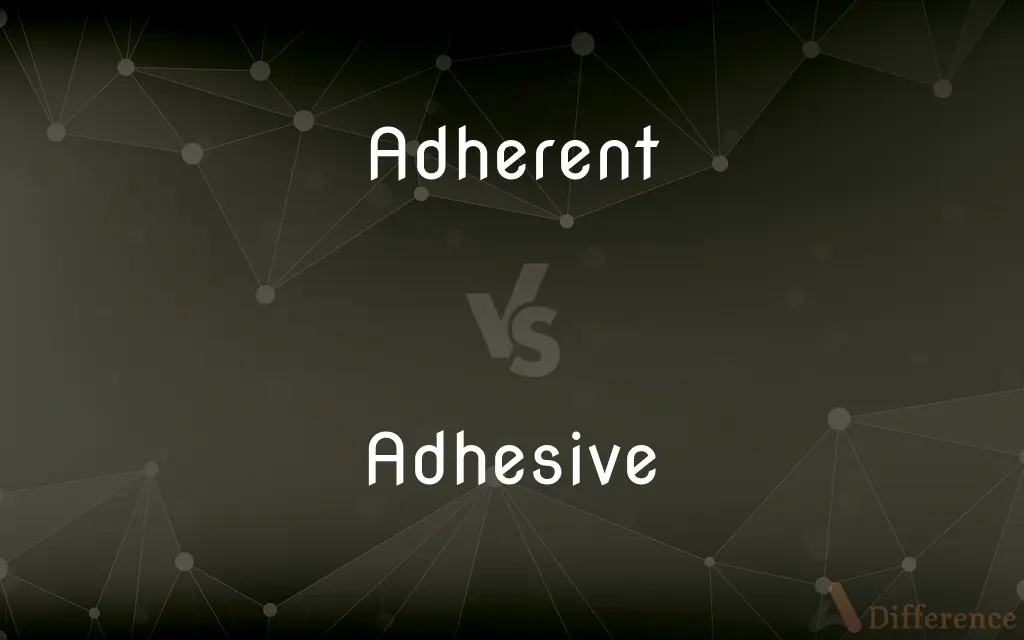Adherent vs. Adhesive — What's the Difference?
By Tayyaba Rehman & Urooj Arif — Updated on April 30, 2024
Adherent refers to a follower or supporter of a cause, person, or party, while adhesive pertains to a substance used for sticking objects together.

Difference Between Adherent and Adhesive
Table of Contents
ADVERTISEMENT
Key Differences
An adherent is typically a person who supports or follows a particular leader, party, or philosophy. It implies a relationship based on allegiance or belief. Conversely, an adhesive is a material such as glue, tape, or paste used to bond surfaces together, focusing on physical attachment rather than ideological support.
While adherents are involved in a dynamic of support and loyalty to ideas or entities, adhesives function through chemical or physical properties that cause different materials to stick together. The interaction in the former is psychological or social, whereas in the latter, it is material and practical.
In social contexts, being an adherent involves a commitment that can be influenced by personal values and societal factors. On the other hand, the effectiveness of an adhesive depends on its chemical composition and the nature of the materials it is used to join.
Adherents are crucial in fields like politics, religion, and culture where advocacy and loyalty play significant roles in forming collective identities. In contrast, adhesives are indispensable in construction, manufacturing, and everyday tasks, emphasizing their role in functional cohesion.
The term "adherent" also can be used in a broader sense to refer to anything that clings to something else, not just in human relationships but also in biological or physical contexts. However, "adhesive" is strictly material, referring to substances specifically formulated to bind or stick.
ADVERTISEMENT
Comparison Chart
Definition
A supporter or follower of a particular idea or leader.
A substance used for bonding materials together.
Application
Social, religious, or political realms.
Industrial, construction, crafts, and everyday usage.
Nature
Psychological or social commitment.
Physical or chemical property of sticking.
Example of Use
Being an adherent of a political movement.
Using an adhesive to fix a broken vase.
Function
Supports and promotes ideas or leaders.
Joins or bonds materials for structural purposes.
Compare with Definitions
Adherent
Associated or connected with something in a dependent or subordinate manner.
The membrane's adherent properties are critical in surgical procedures.
Adhesive
A substance used for sticking objects together, such as glue, tape, or cement.
We need a strong adhesive to repair the wooden frame.
Adherent
A follower of a particular leader, party, or ideology.
She was a staunch adherent of the environmental movement.
Adhesive
Having the quality of sticking or adhering.
The adhesive label won't come off the bottle.
Adherent
Physically sticking to something.
The paint was adherent to the wall despite the humidity.
Adhesive
An agent that causes two surfaces to stick together.
The construction workers applied adhesive to the tiles.
Adherent
Sticking faithfully to something.
He remained adherent to his ethical principles throughout the controversy.
Adhesive
Pertaining to the capacity to adhere.
The adhesive strength of this tape is ideal for heavy boxes.
Adherent
Someone who supports a specific cause or belief.
As an adherent of free speech, he always defends open discussions.
Adhesive
Used in various applications to bind parts.
The craft project required a non-toxic adhesive for safety.
Adherent
A supporter, as of a cause or individual
A vote that pleased adherents of education reform.
Adhesive
Adhesive, also known as glue, cement, mucilage, or paste, is any non-metallic substance applied to one or both surfaces of two separate items that binds them together and resists their separation.The use of adhesives offers certain advantages over other binding techniques such as sewing, mechanical fastenings, or welding. These include the ability to bind different materials together, the more efficient distribution of stress across a joint, the cost-effectiveness of an easily mechanized process, and greater flexibility in design.
Adherent
Sticking or holding fast.
Adhesive
Tending to adhere; sticky.
Adherent
(Botany) Joined but not united. Used of dissimilar parts or organs.
Adhesive
Gummed so as to adhere.
Adherent
Adhesive, sticking to something.
Adhesive
Tending to persist; difficult if not impossible to shake off
"He feels an adhesive dread, a sudden acquaintance with the ... darker side of mankind" (George F. Will).
Adherent
Having the quality of clinging or sticking fast to something.
Adhesive
A substance, such as paste or cement, that provides or promotes adhesion.
Adherent
(botany) Attaching or pressing against a different organ.
Adhesive
Sticky; tenacious, as glutinous substances
Adhesive material
Adhesive tape
Adherent
A person who has membership in some group, association or religion.
Adhesive
Apt or tending to adhere; clinging
Adherent
Sticking; clinging; adhering.
Adhesive
A substance, such as glue, that provides or promotes adhesion
Adherent
Attached as an attribute or circumstance.
Adhesive
Sticky; tenacious, as glutinous substances.
Adherent
Congenitally united with an organ of another kind, as calyx with ovary, or stamens with petals.
Adhesive
Apt or tending to adhere; clinging.
Adherent
One who adheres; one who adheres; one who follows a leader, party, or profession; a follower, or partisan; a believer in a particular faith or church.
Adhesive
A substance that unites or bonds surfaces together
Adherent
That which adheres; an appendage.
Adhesive
Tending to adhere
Adherent
Someone who believes and helps to spread the doctrine of another
Adherent
Sticking fast
Common Curiosities
What distinguishes an adherent from an adhesive in practical terms?
An adherent relates to psychological or ideological attachment, whereas an adhesive refers to a physical substance that causes materials to stick together.
Can "adherent" refer to non-human contexts?
Yes, "adherent" can describe anything that clings or adheres to something else, not only in human relationships but also in physical or biological contexts.
What is the primary function of an adherent?
An adherent primarily supports or follows a particular leader, cause, or ideology.
What is the primary function of an adhesive?
An adhesive's primary function is to bond or stick materials together.
Are adhesives only used in industrial settings?
No, adhesives are used in a wide range of settings including home repairs, crafts, and even in medical applications.
How does an adhesive work?
Adhesives work by forming bonds between the surfaces they are applied to, which can be chemical (polymerization) or physical (adhesion).
What considerations are important when choosing an adhesive for household use?
Considerations include the adhesive's strength, compatibility with the materials, and the environmental conditions it needs to withstand.
Can adhesives be harmful?
Some adhesives contain substances that can be harmful if inhaled or ingested, requiring careful handling and application according to safety guidelines.
What role does an adherent play in society?
Adherents play a significant role in shaping societal norms and promoting ideologies through their support and advocacy.
Is there a psychological component to being an adherent?
Yes, psychological factors like belief systems, values, and identity play significant roles in someone's decision to become an adherent.
Can the effectiveness of an adhesive be temporary?
Yes, the effectiveness of an adhesive can diminish over time due to factors like environmental exposure and material degradation.
Why is the choice of adhesive important in construction?
Choosing the right adhesive is crucial for ensuring structural integrity and durability, especially under various environmental conditions.
What impact do adherents have on cultural institutions?
Adherents can significantly impact cultural institutions by promoting and preserving values and practices through their active engagement and support.
What are some examples of materials that might need adhesives for repair?
Common materials requiring adhesives include wood, plastic, metal, and glass, each possibly requiring different types of adhesives based on their properties.
How do adherents influence political movements?
Adherents can provide critical support, mobilize resources, and help sustain political movements through active participation and advocacy.
Share Your Discovery

Previous Comparison
Attribute vs. Trait
Next Comparison
Higher vs. HighestAuthor Spotlight
Written by
Tayyaba RehmanTayyaba Rehman is a distinguished writer, currently serving as a primary contributor to askdifference.com. As a researcher in semantics and etymology, Tayyaba's passion for the complexity of languages and their distinctions has found a perfect home on the platform. Tayyaba delves into the intricacies of language, distinguishing between commonly confused words and phrases, thereby providing clarity for readers worldwide.
Co-written by
Urooj ArifUrooj is a skilled content writer at Ask Difference, known for her exceptional ability to simplify complex topics into engaging and informative content. With a passion for research and a flair for clear, concise writing, she consistently delivers articles that resonate with our diverse audience.
















































